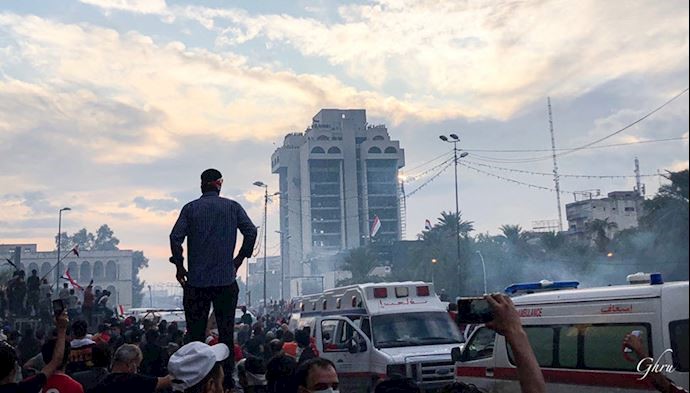Analysis by PMOI/MEK
Iran, October 26, 2019—On Friday, uprisings flared up in Iraq, where the outraged people returned to the streets of Baghdad and other Iraqi cities and cried out their outrage against the Iranian regime and its agents of suppression, especially Qassem Soleimani, the commander of the terrorist Quds force, and its militias.
The protests in Iraq are happening as uprisings continue in Lebanon, where the people are fed up with an inefficient government and the destructive policies of Hezbollah, Tehran’s terrorist proxy in the country.
The uprising continues
After a week of intense protests in early October, the people of Iraq had declared a week in advance that they would resume their protests on Friday. They gathered in Baghdad’s Tahrir Square on the eve and chanted slogans against Soleimani and the Iranian regime. On Friday, the people marched on Baghdad’s Green Zone, where government agencies are stationed, and chanted “Iran out! Iraq Free!” and “The people want the overthrow of the regime.”
Suppressive forces with ties to the Iranian regime opened fire on the protesters. According to news agencies, at 31 protesters have been killed and more than 1,800 injured in Baghdad and other cities during Friday’s protests.
October 25 – Nasiriyah, #Iraq
Protesters torch governor’s office in Dhi Qar Province.pic.twitter.com/q3tA0hNE1o— People’s Mojahedin Organization of Iran (PMOI/MEK) (@Mojahedineng) October 25, 2019
But the protests raged on, conveying the message that despite the brutal crackdown, the people of Iraq will continue to fight for their rights. The Iranian regime and its terrorist agents, who were desperate to maintain their control over Iraq, were not able to contain the rage of the Iraqi people.
The significance of parallel protests in Iraq and Lebanon
In tandem with protests in Iraq, millions of Lebanese people in different cities of the country continue their protests. Among the main reasons of the protests is the heavy influence of Hezbollah, the terrorist organization founded and nurtured by the Iranian regime, in the Lebanese government
The coincidence of these uprisings in these two countries and the common demand of the protesters for the eviction of the Iranian regime and its mercenaries from their countries has caused much fear among Iranian officials. According to various reports, Soleimani has been traveling to Iraq and Lebanon in futile attempts to restore the regime’s control and influence in these two countries.
In its propaganda against the protesters in Iraq and Lebanon, the Iranian regime tried to downplay the uprisings and portray them as scattered and insignificant. Iran’s state-run media reported the protests as having been incited by foreign elements and claimed that the protesters demand mere reforms in the ruling system.
The Iranian regime’s key goal is to preserve the structure of current governments in Iraq and Lebanon, which are deeply under its influence.
The regime’s propaganda against the protests
Iran’s Keyhan Daily, which reflects the views of the regime’s supreme leader Ali Khamenei, wrote on Tuesday, “The protests in Iraq on the days prior to the Arbaeen ceremony [early October] did not have anything to do with the people. The presence of small crowds, the massive destruction and numerous deaths underline the ‘security’ aspect of the protests more than their social element. Also, the fact that the protests called for the dissolution of the government and parliament and the shutdown of the current Iraqi government prove that the unrests in Iraq had no social nature.”
Meanwhile, the media outlets of the so-called reformist camp of the Iranian regime try to portray the protests as demanding reforms. Running a piece titled, “The moderate young generation of the Middle East,” the state-run Ebtekar newspaper wrote Wednesday, “The young generation in the Middle East and their demands must be recognized, whether in Iraq, Algeria, Morocco, Jordan… and Lebanon, where they are crying out their demands from the current political ruling system.”
After Iraq, Lebanon is becoming another strategic blow for #Iran‘s regime in just weeks.#LebanonProtestshttps://t.co/RX6x9xhL5K
— People’s Mojahedin Organization of Iran (PMOI/MEK) (@Mojahedineng) October 19, 2019
But both in Iraq and Lebanon, the people have proven that they will not be deceived by the promises of reform by the corrupt ruling system, and their real demand from the ruling system is its overthrow, which effectively translates to the eviction of the Iranian regime from their country.
The widening cracks in one of the main pillars of the Iranian regime
Iran’s “backyard” is evolving into a hunting ground where its interests are the prey.
These are dangerous times for Tehran, because the regime’s malign regional meddling, parallel to its pursuit of nuclear weapons and domestic crackdown, are the very pillars of the mullahs’ rule. Khamenei had described Iran’s influence across the region, especially Syria, as their “strategic depth.” Any crack in this apparatus have deep impacts inside Iran and especially Tehran.
“Vital issues, such as defensive matters, are non-negotiable,” Khamenei said on … “We will not negotiate with anyone over our military capabilities.”
In another speech delivered earlier this month, Khamenei emphasized, “We must not confine ourselves to a limited atmosphere and care less about the threats behind our borders.”
This is the logic behind the fact that the Iranian regime is willing to deprive millions of Iranians of their basic needs and endure economic suffocation for the sake of providing for its associated militias in Iraq, Syria, Lebanon, Yemen and beyond.
It is crystal clear for Tehran that if foreign battlefields are lost, an even stronger enemy will rise yet again in cities checkered across Iran. There is no doubt that this “enemy” is none other than the Iranian people and youths seeking freedom and democracy.





